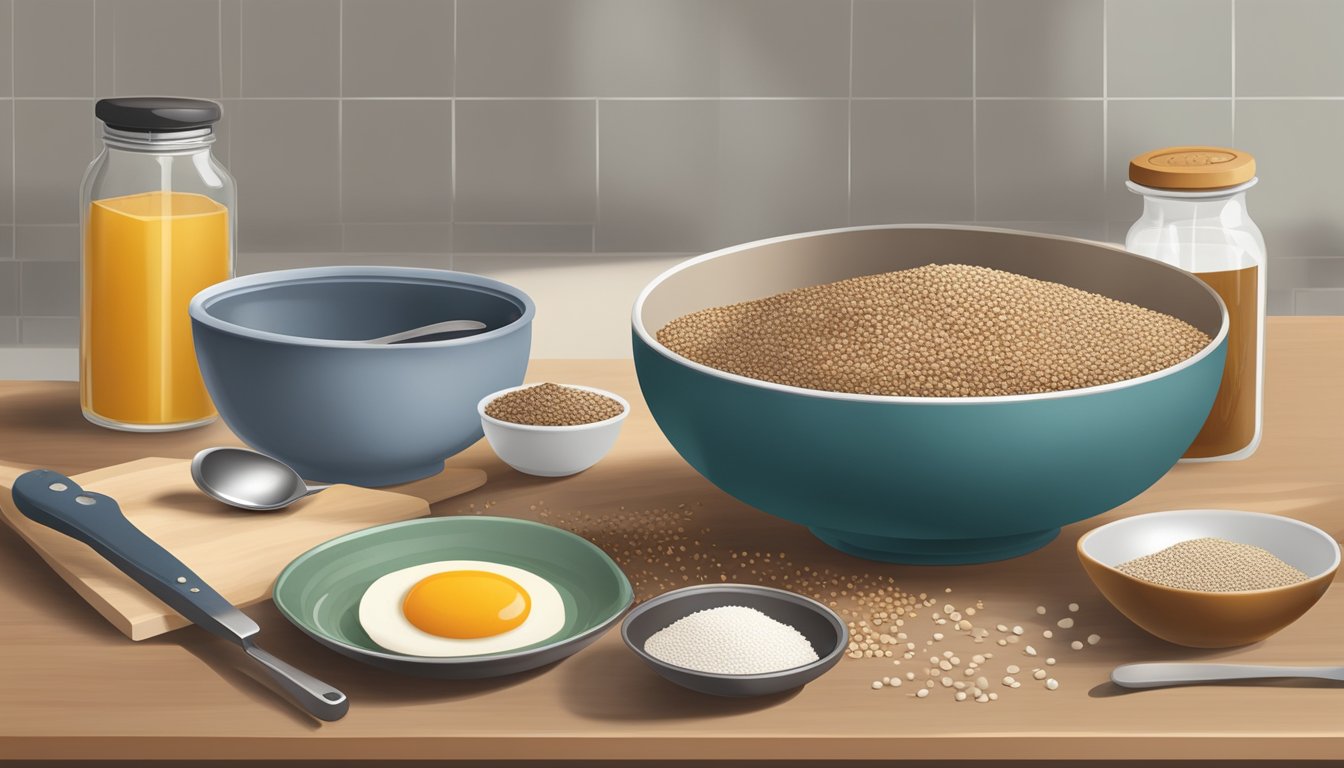Buckwheat has emerged as a nutritional powerhouse, revolutionizing breakfast tables worldwide. This pseudo-cereal, distantly related to rhubarb, offers a gluten-free alternative packed with antioxidants, vitamins, and minerals. Buckwheat’s versatility and high nutritional value make it an ideal choice for a healthy, energizing breakfast.
From fluffy pancakes to creamy porridge, buckwheat adapts to various culinary creations. Its nutty flavor profile adds depth to traditional breakfast dishes, while its nutritional benefits cater to a range of dietary preferences. Buckwheat groats can be simmered with milk or water, creating a hearty porridge that rivals oatmeal in both taste and texture.
Preparing breakfast buckwheat is simple and rewarding. Cooking methods vary from quick stovetop simmering to overnight soaking, allowing for both spontaneous morning meals and pre-planned convenience. With its superfood status and adaptability, buckwheat offers a canvas for creative and nutritious breakfast options that fuel the body and satisfy the palate.
Understanding Buckwheat
Buckwheat is a versatile and nutritious pseudo-grain with a rich history and numerous health benefits. This ancient food source offers a unique nutritional profile that sets it apart from traditional grains.
Origins and Classification
Buckwheat originated in Southeast Asia and has been cultivated for over 8,000 years. Despite its name, buckwheat is not related to wheat or other cereal grains. It belongs to the Polygonaceae family, making it a pseudo-grain or pseudo-cereal.
Botanically, buckwheat is classified as a fruit seed. The plant produces triangular seeds that are harvested and used in various culinary applications. Buckwheat comes in two main varieties: common buckwheat and Tartary buckwheat.
Nutritional Profile
Buckwheat boasts an impressive nutritional profile, making it a valuable addition to any diet. It is rich in complex carbohydrates and provides a good source of plant-based protein.
Key nutrients in buckwheat include:
- Protein: 13-15% by weight
- Dietary fiber: 10% by weight
- Iron: 2.2 mg per 100g
- Potassium: 460 mg per 100g
- Vitamin B6: 0.21 mg per 100g
Buckwheat also contains essential minerals such as magnesium, zinc, and manganese. It is naturally gluten-free, making it suitable for those with celiac disease or gluten sensitivity.
Health Benefits
Buckwheat offers numerous health benefits due to its unique composition of nutrients and bioactive compounds. Its high fiber content supports digestive health and may aid in weight management by promoting feelings of fullness.
The protein in buckwheat is considered complete, containing all nine essential amino acids. This makes it an excellent protein source for vegetarians and vegans.
Buckwheat is rich in antioxidants, particularly rutin and quercetin. These compounds help protect cells from oxidative damage and may reduce the risk of chronic diseases.
Studies suggest that consuming buckwheat may help:
- Lower blood sugar levels
- Reduce cholesterol
- Support heart health
- Improve circulation
The high mineral content, especially magnesium and copper, contributes to bone health and proper immune function.
Buckwheat in the Kitchen
Buckwheat is a versatile ingredient that can be easily incorporated into various dishes. Its unique nutty flavor and nutritional benefits make it an excellent choice for breakfast and beyond.
Selecting and Storing Buckwheat
Choose raw buckwheat groats for optimal freshness and versatility. Look for packages with uniform, pyramid-shaped kernels free from discoloration or moisture. Store buckwheat in an airtight container in a cool, dry place to maintain its quality for up to 6 months.
For longer storage, keep buckwheat in the refrigerator or freezer. This can extend its shelf life up to a year. Always check for signs of spoilage before use, such as an off smell or visible mold.
Toasted buckwheat, also known as kasha, has a stronger flavor and shorter shelf life. Use it within 2-3 months for the best taste and texture.
Preparation Basics
Before cooking, rinse raw buckwheat groats under cold water to remove any debris. This step also helps prevent a mushy texture. Some prefer to soak buckwheat for 30 minutes to 2 hours before cooking, which can reduce cooking time and improve digestibility.
To toast raw buckwheat, heat a dry skillet over medium heat and add the groats. Stir constantly for 4-5 minutes until they turn golden brown and emit a nutty aroma. This step enhances flavor and reduces cooking time.
For 1 cup of buckwheat:
- Water: 1.5 to 2 cups
- Cooking time: 15-20 minutes
- Yield: About 3 cups cooked
Cooking Techniques
Stovetop method: Combine rinsed buckwheat and water in a pot. Bring to a boil, then reduce heat and simmer for 15-20 minutes. Remove from heat and let stand, covered, for 5 minutes. Fluff with a fork before serving.
Rice cooker: Use the same ratio as the stovetop method. Select the “white rice” setting for best results.
Microwave: Mix 1 cup buckwheat with 1.5 cups water in a microwave-safe bowl. Cook on high for 5-6 minutes, then let stand for 2 minutes. Stir and cook for an additional 2-3 minutes if needed.
To avoid mushy buckwheat, don’t overcook or stir too much during cooking. For meal prep, cook a large batch and portion it into containers. Cooked buckwheat can be refrigerated for up to 5 days or frozen for up to 3 months.
Buckwheat Breakfast Options
Buckwheat offers a versatile and nutritious foundation for a variety of breakfast dishes. From creamy porridges to savory plates and fluffy pancakes, this pseudo-cereal adapts to different cooking methods and flavor profiles.
Buckwheat Porridge and Breakfast Bowls
Buckwheat porridge provides a comforting start to the day. To prepare, rinse buckwheat groats and simmer them in water or milk until soft and creamy. Add cinnamon, a pinch of salt, and sweetener to taste.
For a breakfast bowl, combine cooked buckwheat with fresh fruits, nuts, and seeds. A popular option mixes apple chunks, raspberries, and a sprinkle of cinnamon. Pour plant-based milk over the bowl for added creaminess.
Buckwheat kasha, a toasted version of the groats, offers a nuttier flavor profile. It can be prepared similarly to porridge and paired with both sweet and savory toppings.
Savory Buckwheat Dishes
Savory buckwheat dishes provide a hearty alternative to sweet breakfast options. Buckwheat can be cooked and seasoned with herbs, then topped with a fried egg, avocado, and cherry tomatoes for a nutritious breakfast bowl.
Another option is buckwheat breakfast pizza. Spread cooked buckwheat on a baking sheet, add toppings like cheese, vegetables, and eggs, then bake until crispy. This creates a gluten-free alternative to traditional breakfast pizzas.
Buckwheat can also serve as a side dish. Cook it with mushrooms, onions, and garlic for a flavorful accompaniment to breakfast proteins.
Buckwheat Pancakes and Other Griddles
Buckwheat flour produces pancakes with a distinct nutty flavor and hearty texture. Mix it with regular flour or use it alone for gluten-free options. Add milk, eggs, and a leavening agent to create a batter.
For variety, incorporate ingredients like banana, blueberries, or chocolate chips into the batter. Cook the pancakes on a griddle until golden brown on both sides.
Buckwheat waffles offer another griddle option. Use a similar batter as pancakes, but cook in a waffle iron for a crispy exterior. Serve with maple syrup, fresh fruit, or a dollop of yogurt.
Enhancing Buckwheat Dishes
Buckwheat’s versatility shines through its ability to adapt to various culinary styles and flavor combinations. Its unique taste and texture serve as an excellent foundation for both sweet and savory creations.
Culinary Possibilities
Buckwheat’s adaptability extends far beyond traditional breakfast porridge. It excels in savory dishes, lending an earthy flavor and chewy texture to salads, stir-fries, and casseroles. Toasted buckwheat groats add a nutty crunch to yogurt parfaits or homemade granola.
For a twist on classic recipes, substitute a portion of wheat flour with buckwheat flour in pancakes, muffins, or bread. This simple swap introduces a rich, toasty flavor and boosts nutritional value.
Buckwheat noodles, popular in Eastern European and Asian cuisines, offer a hearty alternative to wheat-based pasta. They pair well with robust sauces and stir-fried vegetables.
Flavor Pairings
Buckwheat’s distinctive taste complements a wide range of ingredients. Its earthiness pairs beautifully with:
- Fruits: Apples, pears, berries
- Nuts: Almonds, walnuts, hazelnuts
- Spices: Cinnamon, nutmeg, cardamom
- Herbs: Thyme, rosemary, parsley
- Vegetables: Mushrooms, spinach, roasted squash
For sweet dishes, try combining buckwheat with maple syrup or honey. In savory applications, it works well with robust cheeses, caramelized onions, and roasted garlic.
Creative Recipes
Experiment with these innovative buckwheat-based recipes:
Buckwheat Breakfast Bowl: Cook buckwheat groats in almond milk, top with sliced bananas, a drizzle of honey, and a sprinkle of cinnamon.
Savory Buckwheat Pancakes: Mix buckwheat flour with herbs and grated cheese for a delicious twist on traditional pancakes.
Buckwheat Salad: Toss cooked and cooled buckwheat with roasted vegetables, feta cheese, and a lemon vinaigrette.
Buckwheat Mushroom Risotto: Use buckwheat instead of rice for a nutty, gluten-free alternative to classic risotto.
These recipes cater to various dietary preferences, including vegan and vegetarian options. The soft texture of cooked buckwheat and its ability to absorb flavors make it an ideal base for countless culinary creations.
Special Considerations
Buckwheat offers unique benefits for those with dietary restrictions or specific nutritional needs. Its versatility and nutritional profile make it an excellent choice for various eating patterns.
Gluten Sensitivity and Celiac Disease
Buckwheat is naturally gluten-free, making it a safe option for individuals with celiac disease or gluten intolerance. Despite its name, buckwheat is not related to wheat and contains no gluten proteins.
For those with severe gluten sensitivity, it’s important to check labels and ensure the buckwheat is processed in a gluten-free facility. Cross-contamination can occur during production or packaging.
Buckwheat’s high fiber content and complex carbohydrates provide a nutritious alternative to gluten-containing grains. It offers essential amino acids, making it a valuable protein source for those avoiding gluten.
Incorporating Buckwheat into Various Diets
Buckwheat fits well into many dietary patterns. For vegans and vegetarians, it serves as a complete protein source, containing all nine essential amino acids.
Its low glycemic index makes buckwheat suitable for diabetic diets, helping to regulate blood sugar levels. The high fiber content promotes satiety, aiding in weight management.
Buckwheat’s rich nutritional profile includes minerals like manganese, copper, and magnesium. It also contains antioxidants, particularly rutin, which may support heart health.
For those following whole food diets, buckwheat groats offer a minimally processed option. They can be sprouted to enhance nutrient availability and digestibility.




